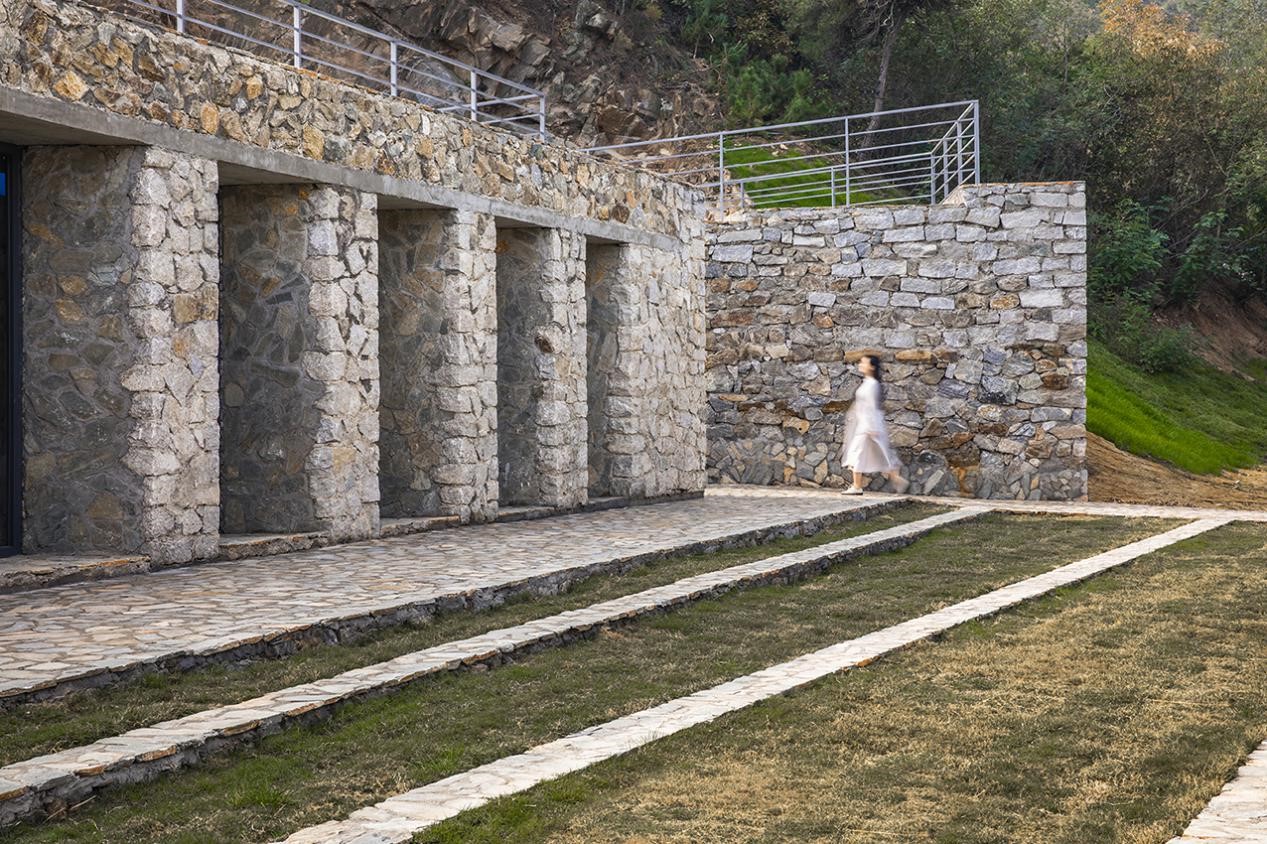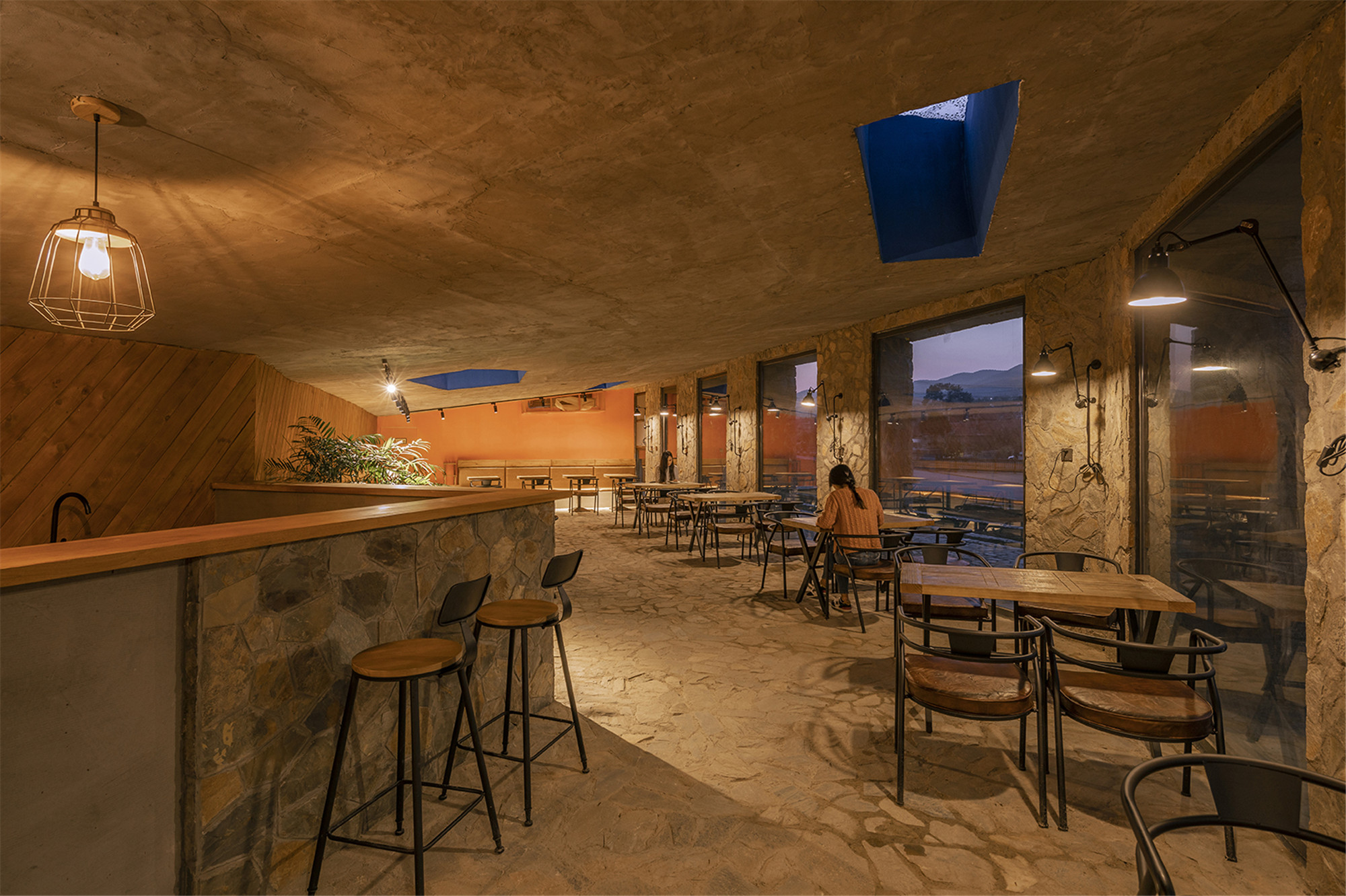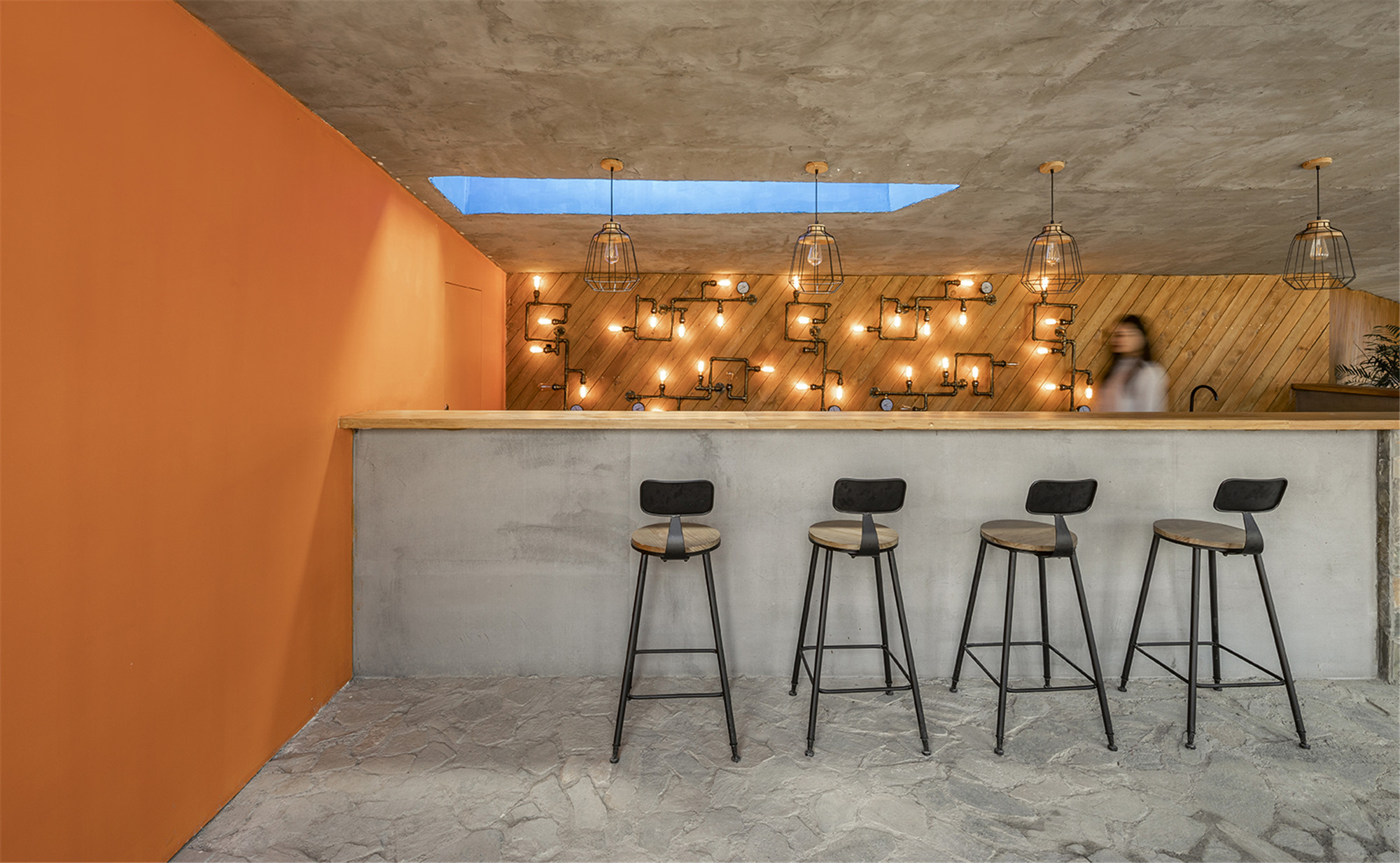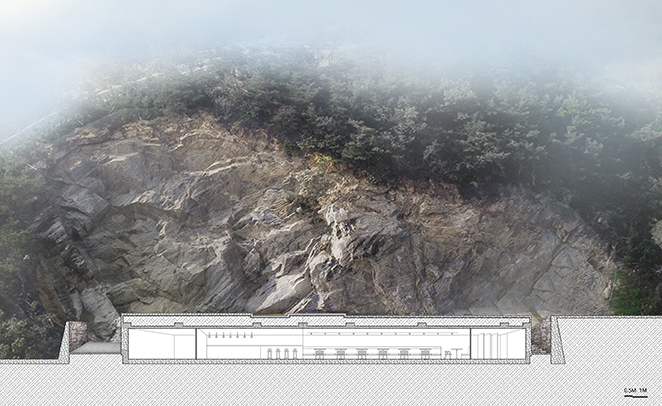可以仰望星空的舞臺,山東威海石窩劇場
Stage under Starlit Sky Stone Nest Amphitheatre in Weihai, Shandong Province
▼石壁被完整保留,舞臺和看臺圍繞石壁設置
Cliff completely preserved, around which stage and grandstand are set

基地,來自對場所的閱讀
A base emerging from reading of site and location
石窩(露天)劇場的前身是一座小型采石坑,位于威海市環翠區嵩山街道五家疃村。上個世紀90年代開始,隨著中國城市化的發展,威海各地出現大量的采石場,這里也曾經是其中的一個。近年來,隨著國家對環保的重視,幾乎所有的采石場都被關閉,此處也逐漸廢棄,成為遺跡,當地人稱之為:“石窩子”。
設計團隊在考察現場時候,發現了被廢棄的采石坑,也發現了它獨有的魅力。采石坑規模不大,形狀如同自然彎曲的手,曾經采石的痕跡經歷了歲月的侵蝕,呈現出一種“人工-自然”的圖景,特別是暴露在外的石壁,崢嶸奇峻,給建筑師留下了深刻的印象。如何將曾經破壞環境的采石場變為造福一方百姓的有益場所是本案著重思考的問題。
In its previous life, the Stone Nest Amphitheatre was a small-sized stone pit located in the Wujiatuan Village at Songshan Residential District in the city of Weihai, Shandong Province, China. Since 1990s, along with the rapid urbanization of China, a great number of stone pits had emerged all over in Weihai, among which this project was one, as well. For the past few years, as the state is paying increasingly attention on environment protection, almost all of the stone pits have been closed. Accordingly, this place had also been gradually discarded and eventually turned into a relic, given a name by the local as “Shi Wozi (Stone Nest)”.
During the site exploration, the design team found this abandoned stone pit by accident and was amazed by its charm. After years of erosion through the time, this relatively small stone pit, in a form of a naturally curved hand, renders a presence of some kind of artificial nature with its old traces of quarrying. The architect has been especially impressed by the exposed jagged precipice and steep cliff. How to transfer this stone pit that once ruined the environment into a public place that will benefit the local people? That has been the biggest question of this project.
▼建筑與周邊村莊關系
Relationship between architecture and surrounding villages

▼從自行車綠道看建筑
Architecture viewed from bicycle greenway

設計靈感,從互文(Intertextuality)開始
The design concept inspired from intertextuality
選擇這里,但這里的未來是什么?這里將作為什么功能被使用?又為周邊帶來什么?……古代希臘的劇場,意大利錫耶納的坎波廣場,以及南京中山陵音樂臺為建筑師提供了靈感。在早年游學歐洲時候,希臘的埃庇道魯斯露天劇場(the Ancient Theatre of Epidaurus)給建筑師留下了深刻的印象,依山而建,面朝遠方,人工構筑物與自然融為一體,形成了一種獨特人文-自然景觀(Cultural-Nature Landscape)。建筑師認為這里的環境雖然和希臘劇場不盡相同,但從空間邏輯上具有互文性(Intertextuality);此外,露天劇場作為一種公共性場域(field),也會給所在的區域帶來新的活力和機遇。它可以作為廣場使用,為當地人提供公共集會的場所,也可舉辦音樂節、戲劇節等活動,形成公共交流。建筑師認為這樣的處理在單純美化景觀的基礎上,增加了文化和產業功能,為此類廢棄工業遺存提供了新的解決思路。
Already chosen, but what does its future look like? What functions are supposed to be granted? And what will it to the surroundings bring? … The ancient Greek amphitheatres, the Piazza del Campo in Siena and the musical stage of Dr Sun Yat-sen' Mausoleum in Nanking have inspired the architect. During his early years of overseas study tour in Europe, the Ancient Theatre of Epidaurus in Greece, leaning against the mountains and facing the distance, has made a profound impression on him with its unique cultural-natural landscape, of which the artificial structures blend perfectly into the nature. Although the environment of this old stone pit is quite different from that of the ancient Greek amphitheatre, the architect finds a logical intertextuality between them and sees that an open-air theatre, as a public field, will bring fresh vigor and new opportunities to the local community, which could be used as a public communication piazza for gatherings, musical and theatrical festivals. More than mere simple beautification of the landscape, this kind of disposal is also supposed to augment cultural and industrial functions to the project, which should provide solution concepts on these abandoned industrial remains.
建筑,人與自然的中間
The architecture between human and nature
從某種意義上講,這是一個景觀性建筑(architecture in landscape)。建筑師希望以一種“輕”的姿態來處理場地,建筑的形態,以及兩者之間的關系。
In a sense, this project is a kind of architecture in landscape. And, according to the architect, a “light” posture should be taken to deal with the site, the architectural form and their relations in between.
▼場地原貌
original view of the site

▼草圖-1
sketch-1

▼草圖-2
sketch-2

▼生成圖
generation diagram

場地中原有石壁被完整的保留,不做任何處理,成為劇場的背景墻。石壁因為開采石料形成弧形,使其具有很好的聲學效果。在建筑師看來,石壁本身就是觀演最重要的內容,它不僅是舞臺背景,也是演出者本身,石壁的存在決定了整個劇場的性格和氣氛,是空間的起點。
看臺環抱石壁設立,從舞臺地平面逐漸抬高,與石壁一起形成聚攏的場。舞臺和看臺的形狀根據原有地形設置,并不追求對稱;看臺的臺階被設計成自由的折線狀態,進一步加強了場地的景觀性。
The cliff of the site is intactly preserved, without any processing, as the background wall of the amphitheatre, which, with its arc-shaped form produced by quarrying, realizes excellent acoustics. From the architect’s point of view, the cliff itself is the most significant content of entire the performance, which is not only the background of the stage, but also one of the major performers. Its existence, as the start point of the whole space, determines the characteristics and atmosphere of the theatre. The audience area is set up hemming in the cliff, of which the height is gently elevated starting from the horizontal plane of the stage, forming a rounding up field. The shapes of the stage and the audience area are fitted to the original terrains, not pursuing symmetry. The seat terraces of the audience area are designed as free broken lines to strengthen the landscape efficacy of the venue.
▼建筑鳥瞰
Bird's eye view of architecture

▼舞臺
Stage

▼石壁與舞臺互相咬合
Cliff and stage biting into each other

▼看臺上設有天窗為下面的咖啡廳提供照明
Skylights on grandstand providing lighting for café below

▼石窩劇場全貌
Full view of Stone Nest Amphitheatre

原場地地坪呈從石壁向下的斜坡,與看臺的抬起趨勢相反。依循這個特征,看臺下面被藏入了一個新的建筑體量。它與看臺共用支撐結構,在功能上包括儲藏、公共衛生間和咖啡廳,可以為劇場提供后勤和公共配套服務。為了不遮擋和搶奪石壁的“主角”地位,建筑高度盡量壓低,外形也趨于規整。建筑正立面由一系列落地窗洞組成,窗洞與窗洞之間的墻面厚度被有意強化,建筑師希望給人一種洞穴的感覺,回應場地原有采石坑的歷史。建筑兩側設有臺階和坡道,供人們進出舞臺區域。臺階和坡道被高大的墻包圍,或略顯壓迫,或曲折,成為進入主區域之前的過渡空間,起到了“欲揚先抑”的效果。建筑材料選用毛石,磊筑,而其中的大部分石塊來自于平整場地時候挖掘出的石頭。建筑師希望從形式和物理屬性上表達建筑是從場地中生長而出的概念。
The ground of the original site is a slope descending downhill from the cliff, contrary to the ascend tendency of the audience area. Complied with this feature, a new architectural structure is added under the audience area, and they share the same supporting system, with functions of storage, public restrooms and café, providing the theatre with logistics and public supporting services. To avoid taking away the protagonist status of the cliff, the height of the architecture has been brought down as possible and its exterior appearance tends to be relatively orderly and neat. A series of French windows form the front architectural fa?ade. And, with intentionally consolidated thick walls between the windows, the architect hopes to give a feeling of a cave, echoing its history as stone pit. On both sides of the building, steps and ramps are arranged for people’s entering and leaving the stage zone, surrounded by high and big walls and slightly oppressive or circuitous, becoming transitional space before entering the main space, which cause an effect of “refraining before highlighting”. Rubbles are chosen as building materials for masonry construction, among which most of the rubbles come from the stones excavated during site formation. Through this, the architect hopes to express the concept that, both in terms of form and physical attributes, the architecture naturally grows out of the site.
▼石頭臺階聯系咖啡和舞臺
Stone steps connecting café and stage

▼建筑立面使用地方傳統壘石工藝
Building facade using local traditional stone-laying technique

在此處,景觀并不是一個獨立存在的內容,建筑也不是。兩者之間存在著相互轉化的可能性。建筑前的綠地被石頭鋪裝的小徑分割成大小不一的區塊,與看臺的臺階劃分形成呼應;進入劇場的流線呈現一個彎曲的弧,人們在登上看臺之前,需要繞建筑至少半周,這也強化了場所的儀式感。
Here, the landscape is not an independent content, and neither is the architecture, between which a possibility of mutual transformation exists. The green belt before the architecture is divided into sections uneven in size by stone pathways, echoing the terrace partition of the audience area. And the traffic line leading into the theatre takes shape of a curve, demanding that people have to walk around the whole architecture for at least a half circle before entering the theatre, which strengthens the sense of ritual, as well.
▼夕陽中的石窩劇場
Stone Nest Amphitheatre in setting sun

▼夜晚的石窩劇場
Stone Nest Amphitheatre at night

▼室內的暖光與舞臺的燈光形成戲劇性效果
Indoor warm light and stage lighting creating dramatic effects

▼使用中的石窩劇場
Stone Nest Amphitheatre in use

室內,略顯粗獷的慵懶
The interior in a rough but languorous style
建筑的室內空間不大,空間布局相對簡單,傾斜的屋頂,不規則的天窗暗示了建筑與看臺的關系,又加強了室內的戲劇性。建筑師希望空間氣氛上給人以熱烈、硬朗的感覺:洞穴、礦坑和工業感是室內設計的基本意向。石材、略顯粗獷的木材、皮革、金屬成為塑造空間的首選材料,工業風的燈具和家具也進一步加強了這種氛圍;暴露的光源形成讓人迷離的炫光,配合東西兩側墻面的橙黃和天窗內壁的寶石藍,建筑室內給人一種復古的慵懶感。
在建筑師的想象中,未來的某一時刻,在這里聽著民謠,喝著啤酒,仰望星空……生活本就應該如此。
The interior space of the architecture is small and relatively simply planned, with slanting roof, on which the irregular skylights imply the connection of the building to the audience area while enhancing the dramaticism indoors. Through the fundamental intension of cave, pit and industrial sense for the interior architecture design, the architect hopes to endow the spatial atmosphere with an ardent and hard touch. Stone, slightly rough timer, leather and metal become the preferred materials for the spatial moulding. Lamps and furniture in industrial style also intensify this aura. Exposed light sources produce enchanting dazzle lighting. Coupled with the orange hue on the east and west walls and the sapphire tone on the inner walls of the skylights, the interior architecture emits a retro lethargic sense.
In the architect’s vision, at some point in the future, people can be listening to folk songs, drinking beer and looking up into the starlit sky, in which way life is actually supposed to be.
▼建筑室內空間作為咖啡廳使用
Interior space of building used as café

▼室內吧臺
Bar in interior space

▼室內
Interior space

▼夜晚鳥瞰
Bird's eye view of architecture at night

▼位置圖
Location

▼建筑總平圖
Site plan

▼石窩劇場爆炸圖
Axonometric explosion

▼一層平面圖
First floor plan

▼剖面圖-1
Section-1

▼剖面圖-2
Section-2

項目信息
名稱:石窩劇場
地點:山東省威海市環翠區嵩山街道五家疃村
業主:嵩山街道人民政府
建筑、室內、景觀設計:三文建筑(www.3andwichdesign.com)
主持建筑師:何崴
設計團隊:陳龍、唐靜、李婉婷、李俊琪、張嬌潔、林培青、趙馨澤、紀梓萌、劉松、李虹雨(實習)
設計時間:2019年3月-6月
建成時間:2019年10月
場地面積:1500平方米
建筑面積:280平方米
攝影:金偉琦
Project info
Project name: Stone Nest Amphitheatre
Location: Wujiatuan Village, Songshan Residential District, Weihai, Shandong Province, China
Client: People’s Government of Songshan Residential District
Architectural, interior architectural and landscape design: 3anwich Design / He Wei Studio
www.3andwichdesign.com
Principle architect: Prof. Dr. He Wei
Design team: Chen Long, Tang Jing, Li Wanting, Li Junqi, Zhang Jiaojie, Lin Peiqing, Zhao Xingze, Ji Zimeng, Liu Song, Li Hongyu(intern)
Land area: 1500 sqm
Construction area: 280 sqm
Design time: Mar. to June, 2019
Completion time: Oct., 2019
Photography: Jin Weiqi
版權聲明:本文版權歸原作者所有,請勿以景觀中國編輯版本轉載。如有侵犯您的權益請及時聯系,我們將第一時間刪除。
投稿郵箱:info@landscape.cn
項目咨詢:18510568018(微信同號)
 京公海網安備 110108000058號
京公海網安備 110108000058號




























 北京朝陽區
北京朝陽區
 www.3andwichdesign.com
www.3andwichdesign.com
 contact_3andwich@126.com
contact_3andwich@126.com
